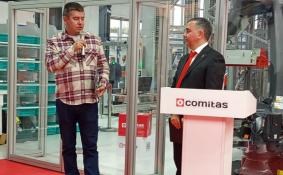Scientific & Practical Journal

Editorial News
We are pleased to present to you the final issue of the journal in 2025 and inform you that LOGISTICS is opening a new page in its development by starting cooperation with the Crystal Growth Foundation, which means that the information saturation of the publication will change for the better. The first issue is dedicated to one of the innovative domestic developments, AI-Kantorovich, which the Crystal Growth Foundation created together with Hive Mind AI.
Dear readers! We are pleased to present to you the eleventh issue of the journal in 2025. There are a lot of relevant and useful materials in the issue, which, hopefully, will not be ignored.
Dear readers! In September the CeMAT RUSSIA exhibition was held, which showed everyone that innovations and robotics are increasingly penetrating the logistics industry. We can safely say that many technologies are tested here, and only then they go out into the world. However, it is not only CeMAT RUSSIA that demonstrates the prevalence of the digital agenda.
PHOTO OF THE WEEK
CITATIONS
All News of Logistics
Freight Report Week 12
Region: Russian River, Azov / Black Sea, Caspian
Trade: Coaster shipments
During the previous week freight improvement on the Azov’s region has stopped, owing to weakening fleet demand, especially with prompt opening dates. As market participants advise, currently French and Canadian wheat is market’s favorite and latest Turkish tender shall be covered by foreign wheat and corn, which is more preferable than Russian price-wise. All this made a heavy impact on Azov’s market, being highly dependent on Turkish Buyers. Rates are not crumbling though, due to Owners, still high from recent freight growth, are trying to push market up, leaving only few successful fixtures actually done. Week 13-th may see spot tonnage numbers at large.
According to current fleet demand for shipments ex River it seems that now supply is overpowered. Most of river cargoes with Black Sea destination have already been covered well before the laycan dates, which bar any rates growth. Price on goods at river elevators is too high, compared to Sea ports, and it will take some time before Sellers make themselves comfortable with market conditions and start making deals in line with realistic prices.
As major analytic agencies declare, potential harvest in Russia may yield 9 000 000 mts of grains more than previous season. Favorable weather conditions along with improving infrastructure of major producing regions being the main cause. Therefore, April-May perhaps shall provide us with increased trading activity, as Producers will try to sell-off as much carry-overs as possible prior to high season.
Tonnage demand for transit cargoes ex Med and Black Seas towards Caspian area is almost nill. Major players are still developing their programmes. Single shipments were done though, with small parcels waiting at transit ports even from year 2018, which due to some reasons were late to pass the early closure of locks on Don River. Several Owners of sea-river vessels are partly repositioning their fleet to ARAG region, foreshadowing the excessive fleet demand for general cargoes destined to Russian inland and Kazakhstan.
Lack of transit parcels also lead to freight decline on Iranian destination. In the absence of competition Charterers of grains are trying to force their vision of workable rates on Ship Owners, which consider Caspian direction. As we’ve heard, there were few fixtures ex Rostov and Azov’s port to Caspian Sea with rates only 3-4$ more than Astrakhan rates. Those Owners, who contracted urea transportation ex Turkmenistan, are now compelled to dump rates in order to escape ballast leg, which have a negative impact on the market.
Traders consider corn to become ‘number one’ commodity on Caspian market before high season starts, as barley stocks are thinned-out. Most lucrative corn offers are currently done basis FOB-Astrakhan and FOB-Makhachkala, sourcing ex Krasnodar region. This may decimate fleet demand ex River ports, wherein ship parcels are ready only on few elevators.
Nowruz influences Iranian market participants – it dramatically slows the local trade. A substantial part of fleet is idle awaiting discharge at Iran, while new contracts are not concluding.













